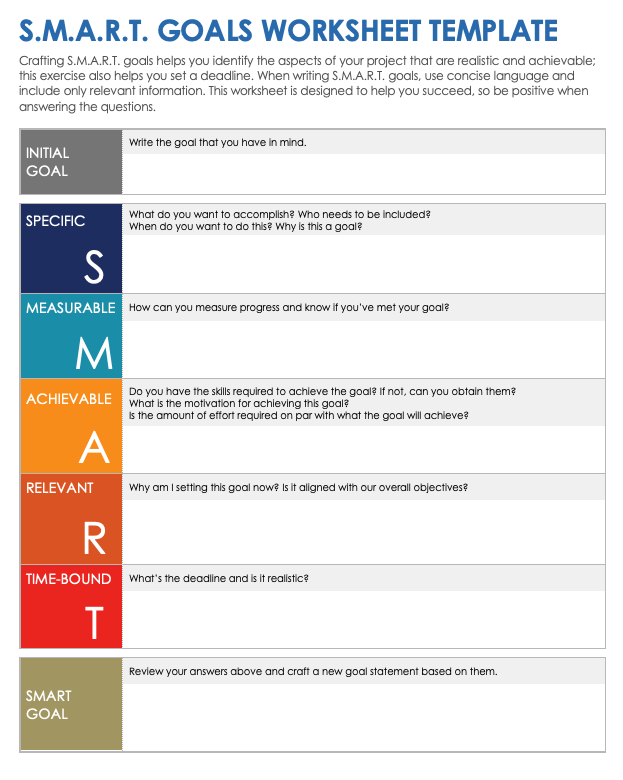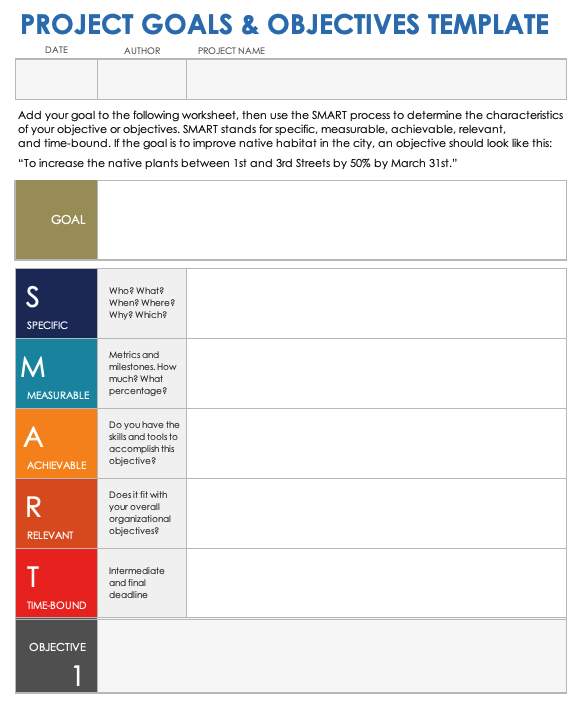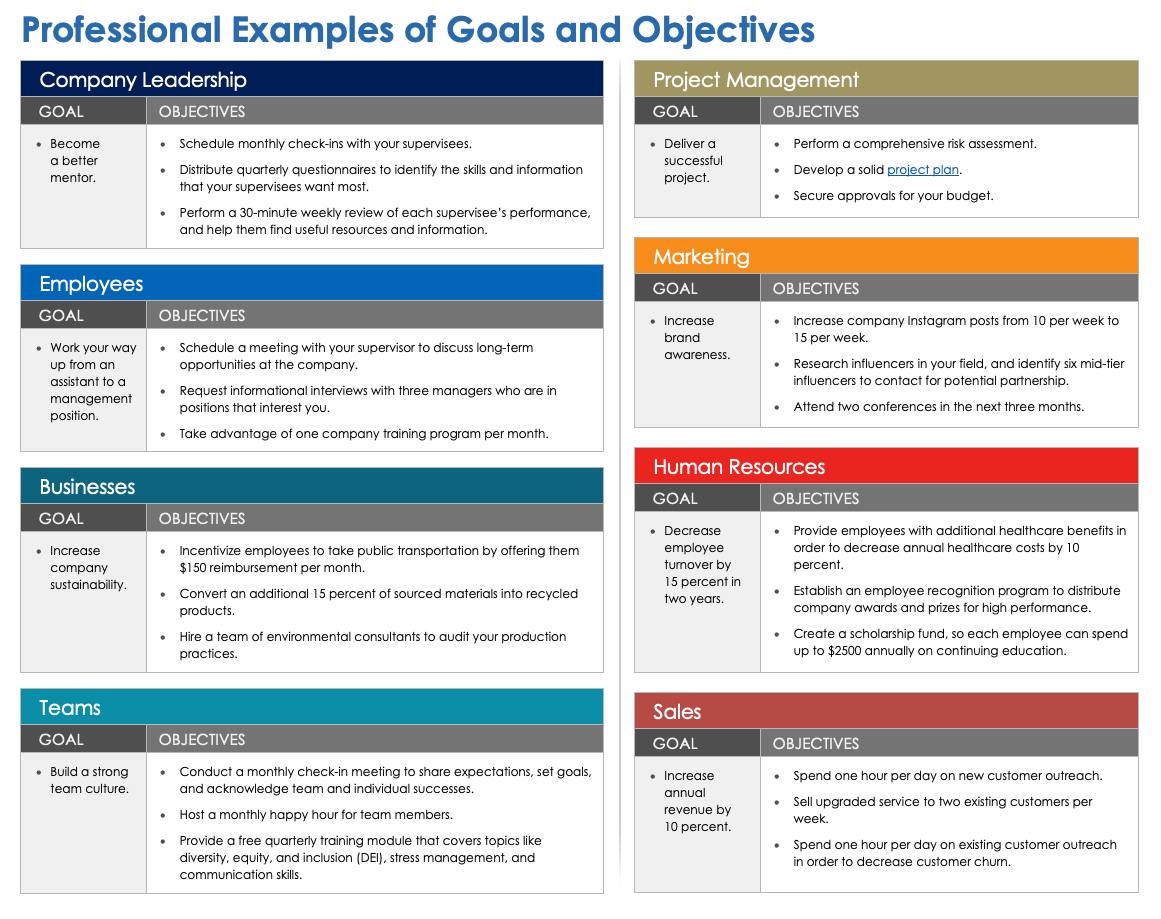What Are Goals?
Goals are desired outcomes or results. By setting goals, teams and individuals can clarify what they want to accomplish with their actions. Effective goals should align with a larger personal or professional vision.
In project management, a single project might have multiple goals, such as growing the customer base, improving website traffic, or increasing the efficiency of a certain process. C-level executives might have broader goals, such as improving profits, becoming more sustainable, or creating a more inclusive work culture. Goals can range in scope and feasibility, but most goals are ambitious and achievable. Think of goals as guiding principles that will give you direction and focus as you work.
“It’s OK to set a goal that’s somewhat broad and relies a little bit on forces out of your control, but it should always be rooted in reality — in what’s practically attainable via realistic means and the objectives you’ll work on day to day,” says Santtu Säävälä, Chief Marketing Officer at Iglu. “It’s not helpful to choose a goal now that’s so ambitious it will take decades or an enormous windfall of luck to achieve. That’s a dream and an ambition, which are good motivators, but less useful for strategic planning and tactical execution.”
One helpful tool for setting goals is the SMART goal framework. SMART goals are specific, measurable, achievable, relevant, and time-bound.
SMART Goals Template for Microsoft Word
Download the SMART Goals Template for Microsoft Word
Use this SMART goals worksheet template to write a SMART goal. The template includes space to explain how your goal is specific, measurable, achievable, relevant, and time-bound. Write your completed goal in the final section, and refer to it as you work toward your desired outcome.
For helpful examples, see this collection of real-life SMART goals.
Time-Bound Goals
Time-bound goals are goals that should be completed within a specific timeframe. These goals can express long-term or short-term outcomes. Time-bound goals are useful for urgent tasks. They can also help motivate teams to make progress on long-term goals.
“Time-bound goals are those that have a specific deadline attached to them,” explains Will Yang, Head of Growth at Instrumentl. “A time-bound goal would be something like, ‘Achieve a 10 percent increase in sales within the next quarter.’”
Säävälä adds that time-bound goals are a useful tool for keeping individuals accountable. “Keeping goals bound to timeframes is a critical factor for building personal accountability. You need to be able to hold yourself to a measure of progress; otherwise, it’s far too easy for competing priorities and day-to-day fires to creep in and convince us it’s fine to push this off.”
Here are three examples Säävälä provides for time-bound goal setting:
- If your goal is to finish development of a new product, by when?
- If you want to achieve a certain market share, by when?
- If you want to engage in a certain new process, over what time period?
“Without time bounds, it’s very hard to set objectives that nest inside your goals, and you lose a key foundation for focus, motivation, and accountability,” he says.
Outcome-Oriented Goals
Outcome-oriented goals are goals that describe a future outcome. These goals might not have a deadline. Instead, they help teams visualize the end result of their efforts. In this way, outcome-oriented goals help provide context and create incentives.
“Outcome-oriented goals are focused on the results you want to achieve, rather than the process of achieving them,” says Yang. “An outcome-oriented goal would be, Gain the highest increase in market share in five years.”
Säävälä recommends outcome-oriented goals for growth-oriented ambitions. “These are exceptionally powerful because they instantly create a perceivable future point that everyone can visualize and work toward,” he explains.
Process-Oriented Goals
Process-oriented goals are goals that focus less on a desired outcome and more on a desired behavior or action. These goals are within the individual’s control. For example, they might aim to complete 20 sales calls every week.
“These [goals] are great for team-building, employee development, and cultural growth, as well as improving balance and implementing new methodologies,” shares Säävälä. “If you’re active in your leadership, you’ll be encountering new perspectives, techniques, tools, and values that have the potential to materially enhance how your business functions and produces.”
Säävälä provides two examples of process-oriented goals:
- Spend 20 minutes a day personally responding to customer feedback on Twitter.
- Recognize the top three contributors to our new CRM database every week.
Other Types of Goals
There are many other types of goals, including growth, quantitative, brand, and milestone goals. Each of these goals is similar to one or more of the three main goal types: time-bound, outcome-oriented, and process-oriented.
Here are some less common types of goals:
- Growth Goal: Similar to an outcome-oriented goal, a growth goal envisions a future outcome that an individual, team, or company can work toward. These goals can involve increasing profits, expanding into new markets, growing professionally, and more.
- Quantitative Goal: Similar to process-oriented goals and time-bound goals, quantitative goals are specific and measurable. Quantitative goals are objective and have clear instructions for completion.
- Qualitative Goal: Unlike a quantitative goal, a qualitative goal is subjective. Like many outcome-oriented goals, these describe a subjective future state that gives teams or individuals a sense of purpose and direction.
- Milestone Goal: Similar to a time-bound goal, a milestone goal describes a deliverable or milestone that moves the team or individual toward a larger goal. Creating milestones in a project helps keep teams on task and encourages a regular feeling of accomplishment. Download a free milestone project template to get started.
What Are Objectives?
Objectives are the small, measurable steps you take toward a larger goal. They tend to be narrow in scope, easy to measure, and realistic. No matter how small, a good objective will move you closer to a desired, long-term outcome.
“Make sure your objective is relevant to your overall goals,” says Yang. “There's no point in setting an objective that doesn't support your larger goals and values.”
Säävälä recommends setting goals first: “Objectives should always support a goal, so it’s important to set goals first. Objectives should be more tactical. In other words, you can see them playing out in your day-to-day life and easily translate them into action-oriented tasks for yourself and your team.”
These are the sample objectives Säävälä provides for the goal, “Launch product X in the European market by 2024:”
- Complete the regulatory approval process by Q3 2023.
- Build a four-person European sales team by Q1 2023.
- Book meetings with six potential distribution partners by Q3 2022.
In the context of a company or organization, there are three main types of objectives: strategic, operational, and tactical. Strategic objectives are long-term and resemble goals, while operational and tactical objectives are short-term.
Strategic Objectives
Strategic objectives ensure that a company’s efforts are aligned with their strategic plan. Of the three types of objectives, strategic objectives are the most similar to goals. They often describe larger, long-term outcomes. Executives and directors typically set strategic objectives.
“A strategic objective is a long-term goal that is aligned with the company's overall vision. For example, a strategic objective might be to increase market share by 10 percent,” says Yang.
Yang’s example is a strategic objective because it describes a desired outcome for the company that aligns with their long-term growth goals.
Tactical Objectives
Tactical objectives are specific and measurable. These are assigned tasks with objective measures. Tactical objectives are nested in strategic objectives and should move you closer to completing long-term goals. Program managers, project managers, business unit managers, and independent teams typically set tactical objectives.
“Tactical objectives are the most tightly focused, short-term actionable tasks that support higher-level objectives and goals,” says Säävälä.
Using one of the example objectives he provided earlier, Säävälä shows how you can use a tactical objective to further break down a goal into manageable tasks: “If our goal is Launch product X in the European market by 2024, and one related objective is Build a four-person European sales team by Q1 2023, a nested tactical objective might be, Interview four qualified candidates for European Sales Manager by Q3 2022.’”
Operational Objectives
Operational objectives are specific, daily activities that break down large goals into smaller tasks. Of the three objective types, these are the simplest and have the shortest terms. Operational objectives tend to be easy to measure and manage. Operations managers, team leaders, and independent teams typically set operational objectives.
These objectives focus on daily, weekly, and monthly tasks that, when taken together, ensure that a business is operating smoothly, and that teams are making progress toward larger goals. “For each goal, there should be multiple operational objectives that directly relate and help break down what needs to be done for success,” says Säävälä.
“All three types of objectives are important in achieving success,” says Yang. “However, operational objectives are typically the most closely monitored because they provide the clearest picture of current performance.”
Project Goals and Objectives Template
Download a Project Goals and Objectives Template for
Excel
|
Microsoft Word
|
Adobe PDF
Download this easy-to-use project goals and objectives template to divide larger goals into smaller, achievable objectives. The template includes space to specify how each objective follows SMART goal criteria, so you can ensure that each objective you set for your team is specific, measurable, achievable, relevant, and time-bound.
Difference Between Goals and Objectives
The terms goal and objective are often used interchangeably. In most cases, goals refer to broad, long-term outcomes, and objectives refer to specific, short-term tasks. Both terms refer to desired outcomes, results, or actions.
Within a project portfolio, goals and objectives ensure that teams are working toward a common vision. Goals often point to a larger purpose, a long-term vision, or a less tangible result, whereas objectives tend to be time-limited, measurable actions with tangible outcomes that help push progress toward broader goals.
| Goal | Objective | |
|---|---|---|
| Purpose | Goals help teams accomplish a broad vision or develop a shared sense of purpose. | Objectives help teams take specific actions to move them toward a common goal. |
| Mindset | Goals require conceptual thinking. | Objectives require strategic thinking, problem-solving, and creativity. |
| Specificity | Goals are unspecific; they tend to be broad, visionary statements. | Objectives are specific. |
| Tangibility | Goals can be either tangible or intangible. | Objectives are always tangible. |
| Measurement | Goals can be difficult to measure or quantify. | Objectives are easy to measure and quantifiable. |
| Scope | Goals are broad in scope. | Objectives are narrow in scope. |
| Timeframe | Goals can be completed over a long period. | Objectives have shorter timeframes and specific deadlines. |
| Feasibility | Most goals are feasible, but some stretch goals might only be aspirational. | Objectives are achievable. |
| Benefits | Goals give teams and individuals vision, focus, and a sense of purpose. | Objectives allow you to make progress toward goals and ultimately achieve them. |
Strategy vs. Objective
A strategy is an approach to a goal, whereas an objective is a step toward achieving that goal. Some objectives are strategic. Strategic objectives describe long-term outcomes that align with larger goals.
If a business adopts a growth strategy, then they are trying to expand their company. In this case, a goal might be to add more products or services. An objective would be to assemble a development team for a new product by the end of Q2.
Learn more about strategy and how it differs from tactics.
Goals vs. Objectives in Project Management
In project management, setting goals and objectives early on in the project lifecycle is key. Set goals to establish a broad, desired outcome for a project. Set objectives to ensure your team makes progress toward those goals.
“Goals are the broad, overarching targets that you hope to achieve, while objectives are the specific steps or actions that you plan to take in order to reach those goals,” says Linda Shaffer, Chief People and Operations Officer at Checkr. “If you're confused, think of it this way: your goal is the what, while your objectives are the how.”
Leadership Goals and Objectives Examples
All company leaders can benefit from regular goal and objective setting. Use goals and objectives to improve skills, create a better company culture, develop more efficient processes, and more.
Here are some examples of leadership goals and objectives:
| Leadership Goals | Objectives |
|---|---|
|
|
|
|
|
|
Employee Goals and Objectives Examples
Employees in any industry or position can use goals and objectives to increase productivity, advance to a more senior position, decrease work-related stress, and more. Seeing examples of goals and objectives can help you create your own.
Here are some examples of employee goals and objectives:
| Employee Goals | Objectives |
|---|---|
|
|
|
|
|
|
Business Goals and Objectives Examples
Any business — from a small business to a global organization — can use goals and objectives to improve company finances, become more environmentally sustainable, improve workplace culture, and more. Examples of business goals and objectives can help a company create their own.
Here are some examples of business goals and objectives:
| Business Goals | Objectives |
|---|---|
| Increase market share by 10 percent. |
|
| Increase company sustainability. |
|
| Lower your company’s debt-to-capital ratio. |
|
Team Goals and Objectives Examples
Teams in any industry can use goals and objectives to stay aligned on their vision and improve performance. Reviewing example objectives can help companies ensure they are setting ones that work toward a common goal.
Here are some examples of goals and objectives for teams:
| Team Goals | Objectives |
|---|---|
|
|
|
|
|
|
Project Management Goals and Objectives Examples
Setting goals and objectives is a key part of project management. Goals and objectives can help project managers increase project success rates, ensure more accurate budgeting, create efficient processes, and more.
Here are some examples of project management goals and objectives:
| Project Management Goal | Objectives |
|---|---|
|
|
|
|
|
|
Human Resources Goals and Objectives Examples
Human resources (HR) personnel and leadership can use goals and objectives to improve hiring processes and create more effective training programs. They can also use them to build a more positive company culture and more. Examples are a good way to see how other HR departments are using objectives to meet goals.
Here are some examples of human resources goals and objectives:
| Human Resources Goals | Objectives |
|---|---|
|
|
|
|
|
|
Marketing Goals and Objectives Examples
Marketing professionals can use examples of goals and objectives to find ways to expand the reach of their brand, make more impactful advertisements. They are also useful for generating leads, expanding their online presence, and more.
Here are some examples of marketing goals and objectives:
| Marketing Goals | Objectives |
|---|---|
|
|
|
|
|
|
Benefits of Setting Workplace Goals and Objectives
Many benefits come from setting goals and objectives in the workplace. Some include a clearer shared vision for the future, increased motivation, and a more manageable workload. They are also effective for creating more accountability and minimizing surprises and setbacks.
Here are some benefits of setting goals and objectives:
- Clearer Vision: Setting goals and objectives helps unify a vision across a team or organization and assure individual team members that everyone is progressing toward a common purpose.
“You’re giving your company and everyone in it a clear, unified vision for the future,” says Säävälä. “Everyone knows which direction they’re supposed to be rowing, which creates harmony, unity and immeasurable efficiency compared to companies that operate on the whims of a CEO or an executive team that doesn’t share vision.” - More Manageable Workload: When teams break down large, unwieldy goals into manageable, measurable objectives, it becomes easier to delegate work, and employees are less likely to feel overwhelmed and burned out.
- Fewer Surprises and Setbacks: “Everyone knows what they’re meant to be doing and how their mission affects everyone else. If something can’t be achieved, that may be OK,” explains Säävälä. “Things happen in the real world. But having objectives at every level encourages employees to communicate any misalignment as early as possible, which minimizes surprises and the need to spend resources on triage.”
- Increased Motivation: When there is a clear vision across a team or an organization, individuals will feel more confident in it. “Creating goals and objectives gives you a sense of purpose and direction in your career. It can help you stay motivated and focused on what's important,” advises Shaffer.
- Better Time and Resource Management: Goals and objectives make it easier to prioritize tasks. “In the workplace, goal-setting can be a valuable tool for managing time and resources, as it allows an organization to prioritize tasks and allocate resources more effectively,” says Yang.
- More Accountability: Clear objectives are easy to measure and track, which means everyone is held accountable for their contributions to a vision. “Perhaps most measurably, integrated and intelligently set objectives that are well-communicated create incontestable accountability at every level,” shares Säävälä.
- Clearer Progress: Goals and objectives help create clear metrics for success. “Having goals and objectives gives you something to measure your progress against. This can help you track your progress and make necessary adjustments along the way,” says Shaffer.
- Better Communication: “Workplace goals and objectives can help improve communication between you and your boss. By sharing your goals and objectives with your boss, you can get feedback and guidance on how to best achieve those goals,” suggests Shaffer.
How to Measure Goals and Objectives
There are many ways to measure goals and objectives. Measure goals with point systems, yes/no questions, and rubrics, as well as by reviewing outcomes. Measure objectives with data surveys, outputs, and performance reviews.
“Goals are typically measured in terms of progress made toward achieving them. Objectives, on the other hand, are often measured in terms of how well they are met,” says Shaffer. “For example, if your goal is to increase sales by 20 percent, you would measure this by tracking sales figures over time. If your objective is to make 100 sales calls this week, you would measure this by tracking the number of sales calls made.”
Generally speaking, measuring goals means measuring outcomes, while measuring objectives means measuring outputs. Säävälä explains that the specific method you choose to measure goals and objectives will always depend on how you set them in the first place: “Measuring goals and objectives entirely depends on how they’re set and worded. Measurability should always be a core consideration when choosing them, and if it is, determining success or failure will be simple.”
This is why specificity is important in the early stages of goal and objective setting. “Broader goals such as Achieve 25 percent market share by 20XX may take some more work to measure, while also being more subjective to different metrics. But I would argue that simply makes the goals weaker than they need to be,” says Säävälä. “Achieve 25 percent global market share in the PC market according to Quality Intel’s annual rankings takes all the uncertainty out of the equation.”
Here are some common ways to measure your overarching goals:
- Yes/No Questions: Ask a close-ended question. Did you meet the goal?
- Point System: Assign a point system for measuring goals that have many steps. How much of your goal did you achieve?
- Rubric: Design a series of subjective questions about your multifaceted goal that you can assign a value to. Use this rubric to gauge how close you were to reaching your goals for various criteria.
- Outcomes: Ask yourself about the overall outcomes of your actions. Did they achieve something other than what you expected?
Here are some common ways to measure your specific objectives:
- Attainment: For quantifiable objectives, determine how close you were to achieving your target dollar amount, percentage, or quantity.
- Qualitative Data with Surveys: For more qualitative objectives, distribute surveys.
- Performance Review: Conduct a thorough performance review comparing past and present performance.
- Outputs: List specific outputs that you were able to produce.
Easily Track and Monitor the Progress of Goals and Objectives with Smartsheet
Empower your people to go above and beyond with a flexible platform designed to match the needs of your team — and adapt as those needs change.
The Smartsheet platform makes it easy to plan, capture, manage, and report on work from anywhere, helping your team be more effective and get more done. Report on key metrics and get real-time visibility into work as it happens with roll-up reports, dashboards, and automated workflows built to keep your team connected and informed.
When teams have clarity into the work getting done, there’s no telling how much more they can accomplish in the same amount of time. Try Smartsheet for free, today.




